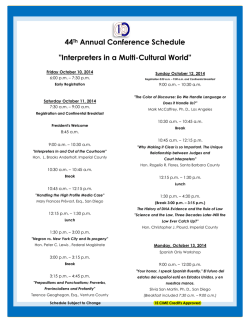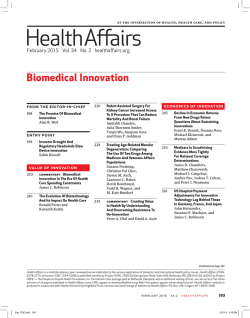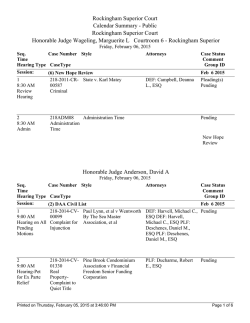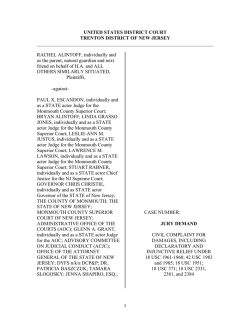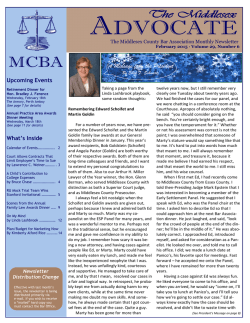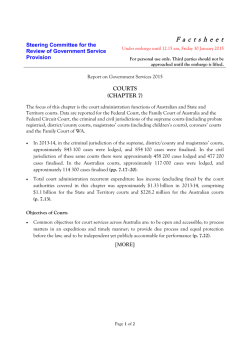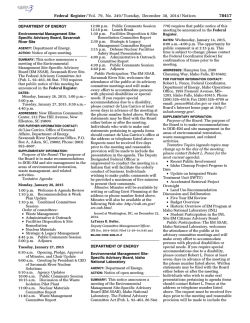
Report on Proposed Amendments to Federal Rules of Appellate
REPORT OF THE ASSOCIATION OF THE BAR OF THE CITY OF NEW YORK ON PROPOSED AMENDMENTS TO THE FEDERAL RULES OF APPELLATE PROCEDURE The Association of the Bar of the City of New York, through its Committee on Federal Courts (the “Federal Courts Committee”), greatly appreciates the opportunity for public comment provided by the Judicial Conference’s Committee on Rules of Practice and Procedure on the amendments to the Federal Rules of Appellate Procedure proposed by the Advisory Committee on Appellate Rules. The Association, founded in 1870, has over 24,000 members practicing throughout the nation and in more than fifty foreign jurisdictions. The Association includes among its membership many lawyers in every area of law practice, including lawyers generally representing plaintiffs and those generally representing defendants; lawyers in large firms, in small firms, and in solo practice; and lawyers in private practice, government service, public defender organizations, and in-house counsel at corporations. The Association’s Federal Courts Committee is charged with responsibility for reviewing and making recommendations regarding proposed amendments to the Federal Rules of Appellate Procedure. The Federal Courts Committee respectfully submits the following comments on the proposed amendments: I. LENGTH LIMITS A. Rule 32: Word limits on Principal Briefs and Reply Briefs The Federal Courts Committee respectfully opposes the reduction in the word count limits for principal briefs from 14,000 to 12,500 words, and the corresponding reduction in the word 1 count limit for reply briefs. The Federal Courts Committee believes strongly that the current 14,000 word limit is often necessary in complex cases to permit each party to present its statement of the case, summary of argument and argument on the legal issues. While meeting the 14,000 word limit in complex 1 We likewise oppose reducing the current word limit for cross appeals (Rule 28.1). 1 cases typically requires significant editing, counsel do generally seek to edit their briefs to meet the 14,000 word limit rather than submitting an application for permission to file a brief in excess of the limit. A reduction in the word count limit would often compel counsel in complex cases either to unduly truncate their presentation of the factual record relevant to the issues on appeal and their legal arguments or, alternatively, to seek permission to file a brief in excess of the proposed new (lower) word limits. Either course is likely to increase the burden on the Courts of Appeals, and creates the risk of unfairness to litigants in some cases where they simply may not have sufficient space to clearly articulate the relevant facts and legal arguments. The Federal Courts Committee believes that such a significant change in established practice should not be made without a compelling justification. Yet the Report of the Advisory Committee on the Appellate Rules does not identify any basis in experience since the current word counts were adopted in 1998 that demonstrates a need to modify the existing word limits. Moreover, members of our committee are not aware, from their own experience, of any practical problems flowing from the existing word limits, and do not believe that the current word limits encourage unnecessarily lengthy briefs in cases where that length is not warranted. The sole rationale provided by the Advisory Committee for the proposed change in the word limits is the assertion that the 14,000-word limit “appears to have been based” on the “assumption” that one page of a brief was (prior to the 1998 amendments) equivalent to 280 words. The Advisory Committee takes the position that this “assumption” was incorrect, and that – based on a 1993 study prepared by an advisory committee in the D.C. Circuit – “250 words per page is closer to the mark.” Report of Advisory Committee on Appellate Rules, dated May 8, 2014 (revised June 2 6, 2014), at 18 of 372. We respectfully submit that this rationale does not provide a sufficient basis for upsetting the word limits that have been in place for principal briefs and reply briefs for over 15 years. In addition to the points made above, several additional considerations reinforce our concern 2 Page references are to the Preliminary Draft of Proposed Amendments to the Federal Rules of Appellate, Bankruptcy, Civil and Criminal Procedure, August 2014. 2 about the Advisory Committee’s reliance on one over-20-year-old study, which was conducted over five years before the 1998 amendments that established the current word limits: (1) The Advisory Committee Notes to the 1998 amendments reflect a comprehensive analysis of form, typeface and type-volume limitation issues. The discussion of type-volume limitations reflects a recognition that the use of a proportional typeface can increase the amount of material per page as compared to the use of a monospaced typeface, as well as other technical considerations that may influence the length of a brief. Thus, the word limits adopted in the 1998 amendments appear to be the product of careful focus and consideration, and there is insufficient basis for the Advisory Committee’s view that the word limits adopted were the product of inadvertence. (2) The July 1993 study that is referenced in the Report of the Advisory Committee (see id. at 20-24 of 372, and 54 of 372) is hardly a comprehensive study of issues relating to brief length. It relies upon a very limited selection of briefs from only three sources: ten principal briefs and ten reply briefs from a Department of Justice Civil Division archive of appellate briefs, plus five appellate briefs filed by the FCC and three appellate briefs filed by the law firm of Wilmer Cutler and Pickering. According to the 1993 study, these briefs were not randomly selected; rather, briefs that the authors subjectively viewed as containing an excessive number of single-space footnotes and block quotes were avoided. Overall, the average word count is said to have approximated 250 words per page. But the 28 briefs considered ranged in word count up to 288 words per page, and five of the 28 briefs had 270 or more words per page. And the fact that differences in the formatting of particular briefs could account for different per page word counts – as is evident from the fact that one of the 28 briefs considered had over 288 words per page – also underscores the inappropriateness of relying upon this over-20-year-old study to change the word 3 limits in place since 1998. 3 As noted, the study considered only 28 non-randomly selected briefs from three sources. The format used in those briefs could have impacted the per page word count. Among other things, the 1993 study suggests the briefs studied included the captions and signature blocks. See page 21 of 3 In any event, the July 1993 study, as well as the local circuit rule based on an estimate of 250 words per page also referred to in the Report of the Advisory Committee on Appellate Rules (see p. 54 of 372), were presumably part of the body of material available to those working on the 1998 amendments. Yet the 1998 amendments adopted the current word limits and chose not to incorporate a word limit based on 250 words per page. One may infer that the 14,000 word limit adopted for principal briefs was not the result of “inadvertent” error, but rather was deemed appropriate when one took into consideration potential differences in word count for briefs based on different formats and typefaces utilized at the time of the 1998 amendments as well as other considerations. Members of our committee have anecdotally checked the word count per page in recent appellate briefs (which now reflect the 14 point or larger typeface required by Rule 32(a)(5), also a product of the 1998 amendments) as well as district court papers that comply with district court margin requirements and use 12 point typeface (larger than the 11 point typeface permitted prior to the 1998 amendments). Typical appellate briefs using 14 point typeface average 240 words per page (use of 11 point typeface, as permitted before the 1998 amendments, would yield significantly more words per page). Typical district court papers using 12 point typeface (larger than the 11 point typeface permitted by FRAP 32 before 1998), and margins consistent with pre-1998 FRAP Rule 32, can significantly exceed 280 words per page. We point to this admittedly anecdotal information not in an effort to establish the “correct” word count per page that might have been expected in a pre-1998 brief, but rather simply to make the point that the limited number of briefs considered in one over-20-year-old study may not have been representative, and that it does not make sense, in 2014, to be modifying a long-established and accepted word count limit based on a count of words in 28 briefs from 3 sources in an over 20 year-old study. 372. If one makes adjustments for the space used for the case caption (which could take up 1/3, or more, of the first page of a brief) and the signature block – neither of which need to be considered in a word count – the briefs studied would have averaged a greater number of words per page of actual text. In addition, the lines of text used per page and the typeface used could both have impacted the word count. 4 B. Word Limits for Other Papers We agree with the proposal to provide for a volume limitation based on a word count (or lines of text printed in a monospace typeface), for papers produced using computers, for petitions for permission to appeal (Rule 5), writs of mandamus (Rule 21), motions (Rule 27), petitions for hearing or rehearing en banc (Rule 35), and petitions for panel rehearing (Rule 40). However, we believe the page-to-word conversion should be based on the convention of 280 words per page, utilized in connection with the 1998 amendments, for principal briefs and reply briefs. Since the current rules that utilize page limits have been in place even as filings have gravitated to the use of proportional type, utilizing a conversion of pages to words lower than the 280 words per page assumed at the time of the 1998 amendments would effect a significant reduction in length versus current practice, as well as a reduction in length compared to the practice that existed in 1998 when word limits were first adopted for principal briefs. Petitions for permission to appeal, writs of mandamus, motions and petitions for rehearing can entail important issues and it benefits both the parties and the Courts of Appeals to allow counsel adequate latitude to present their positions. Moreover, there is no indication in the Report of the Advisory Committee on Appellate Rules that the current page limits – even with the use of proportional type – result in excessively long papers not warranted by the complexity of the issues being addressed. 5 II. BRIEFS OF AN AMICUS CURIAE DURING CONSIDERATION OF WHETHER TO GRANT RE-HEARING The proposed amendments to FRAP 29 would establish specific rules governing the time in which an amicus curiae must file its brief, accompanied by a motion for filing when necessary, in support of a petition for rehearing. For some unexplained reason, the proposed rule requires such an amicus brief to be filed no later than three days after the petition is filed (for amicus curiae supporting the petition or supporting neither party), rather than the seven days permitted by Rule 29 for amicus briefs filed during briefing of the appeal; the proposed amendments also require an amicus curiae opposing a petition to file on the same date set for responses by the parties, instead of seven days later. The current Rule, by permitting an amicus curiae to file no later than seven days after the principal brief of the party being supported, allows an amicus curiae to take into account the arguments of the party it supports when finalizing its own brief. No reason is given in the Report of the Advisory Committee on Appellate Rules for shortening the time for filing amicus briefs in the case of petitions for panel rehearing or rehearing en banc, and it is not clear why allowing the sevenday period of time currently permitted presents a practical problem in the case of petitions for panel rehearing or rehearing en banc. In the experience of the members of the Federal Courts Committee, there is rarely an extraordinary need for urgency with respect to the filing of briefs on rehearing, nor do the Courts of Appeals typically address petitions for rehearing with the urgency that the proposed rule seems to assume. And in cases where there is a need for urgency in the disposition of a petition for rehearing, the Court of Appeals can issue an order modifying the usual schedule for the filing of amicus briefs. 6 Finally, we believe the applicable word limit for petitions for rehearing should be based on the 280 words per page convention, for the reasons expressed above. Dated: 4 January 28, 2015 New York, New York Respectfully submitted, Committee on Federal Courts Association of the Bar of the City of New York Ira M. Feinberg, Chair Benjamin A. Fleming, Secretary Cindy P. Abramson, Esq. Alex Bein Neil S. Binder, Esq. Laura G. Birger, Esq. Julia L. Brickell, Esq. Daniel Joseph Brooks, Esq. Olga Kaplan Buland, Esq. Partha P. Chattoraj, Esq. Theodore K. Cheng, Esq. James Clare, Esq. Seth D. Eichenholtz, Esq. Brian J. Farrar, Esq. Michael S. Flynn, Esq. The Honorable Martin Glenn Jason M. Halper, Esq. Peter C. Hein, Esq. Anna Kadyshevich, Esq. Anne Catharine Lefever, Esq. Michelle L. Levin, Esq. Elaine K. Lou, Esq. John M. Lundin, Esq. Margaret Malloy, Esq. Glen G. McGorty, Esq. 4 The Advisory Committee also proposes to amend FRAP 26(c) to remove service by electronic means from the modes of service that allow three added days to act after being served. This proposal parallels a similar proposal to modify the Federal Rules of Civil Procedure. The Federal Courts Committee supports this proposal, for the reasons outlined in a separate report of the Association of the Bar of the City of New York on the proposed amendments to the Federal Rules of Civil Procedure. 7 Natalie Marcus, Esq. Pamela Miller, Esq. Concepcion A. Montoya Parvin D. Moyne, Esq. Eric S. Olney, Esq. Winston Paes, Esq. Francesca J. Perkins, Esq. Carolyn Pokorny, Esq. Clay J. Pierce, Esq. Nathaniel P.T. Read, Esq. Harry Rimm, Esq. Jorge Salva, Esq. The Honorable Vera M. Scanlon MaryAnn Sung, Esq. Jeffrey A. Udell, Esq. Jeannette A. Vargas, Esq. George S. Wang, Esq. William R. Weinstein, Esq. Robert Weintraub, Esq. Sidney N. Weiss, Esq. Adrienne Eason Wheatley, Esq. Sam A. Yospe, Esq. 8
© Copyright 2025
